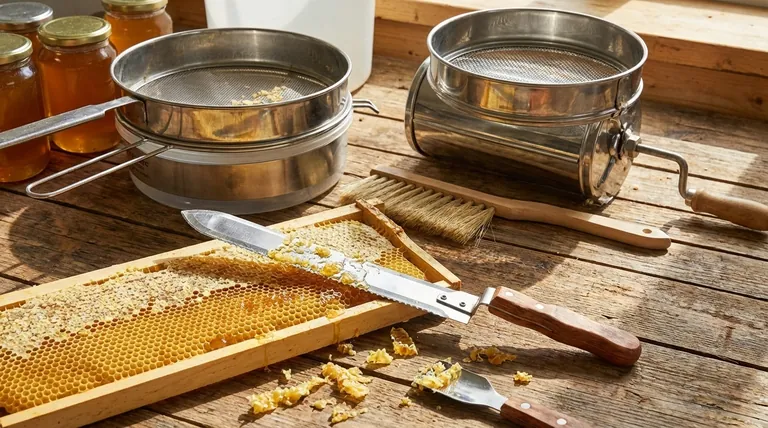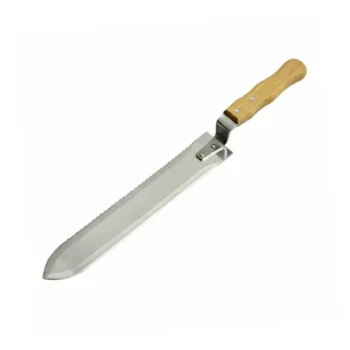At its core, honey extraction requires three fundamental tools. You need a way to remove the wax cappings from the honeycomb, a method to get the honey out of the comb, and containers to hold the final product. The most common setup involves an uncapping knife, a honey extractor, and food-grade buckets.
The specific tools you need are dictated by your chosen extraction method and the scale of your operation. While a centrifugal extractor is standard, simpler methods exist, and the entire process is a system, from removing bees off the frames to bottling the finished honey.

The Three Stages of Honey Extraction
Successfully harvesting honey is a systematic process. Breaking it down into stages helps clarify which tools are needed at each step, ensuring a smooth and efficient workflow from the hive to the jar.
Stage 1: Removing Bees from the Frames
Before you can extract honey, you must safely and gently remove the bees from the honey-filled frames.
Your primary tool for this is a soft bee brush. This is used to gently sweep the remaining bees off each frame as you remove it from the super.
For a less manual approach, you can use a fume board or a triangle escape board. These devices are placed on the hive a day before extraction to encourage bees to move out of the honey supers on their own.
Stage 2: Uncapping the Honeycomb
Bees seal their finished honey in comb cells with a thin layer of beeswax called "cappings." This wax must be removed to release the honey.
The most common tool is an uncapping knife, which comes in heated (electric) and unheated ("cold") versions. A hot knife slices through the wax with ease.
Alternatively, an uncapping scratcher or fork works like a comb to pierce and lift the cappings. This is particularly useful for low spots on the comb that a knife might miss. You will also need an uncapping tank or a simple bucket to catch the wax cappings, which are rich with honey.
Stage 3: Extracting and Filtering the Honey
This is the stage where honey is physically removed from the comb cells.
The central piece of equipment here is the honey extractor. This machine uses centrifugal force to spin the honey out of the frames without destroying the comb. Extractors can be manual (hand-cranked) or motorized (electric) and come in various sizes.
Once extracted, the honey flows into a bottling bucket, which is a food-grade pail fitted with a honey gate (a type of spigot). Before it gets there, it must be strained through filters or a double sieve to remove wax particles and other debris, ensuring a clean final product.
Understanding the Trade-offs
Choosing the right equipment involves balancing cost, efficiency, and the scale of your beekeeping. Not every tool is right for every situation.
Manual vs. Electric Extractors
A manual extractor is less expensive and perfect for a hobbyist with only a few hives. It requires significant physical effort but gives you precise control.
An electric extractor is a major investment in time-saving and efficiency. It is essential for anyone managing more than a handful of hives, as it dramatically reduces the labor involved.
Hot vs. Cold Uncapping Knives
A hot knife melts through the wax cappings quickly and cleanly, which speeds up the process considerably. The primary risk is overheating the honey if you aren't careful, which can degrade its quality.
A cold knife or scratcher requires more effort but eliminates any risk of heat damage. This is a simple, effective, and low-cost option for beginners.
The Extractor vs. Crush and Strain Method
While an extractor preserves the delicate honeycomb for the bees to reuse, it is a significant expense.
The crush and strain method is a low-cost alternative. It involves simply mashing the entire comb in a bucket and then straining the honey through cheesecloth or filters. The major drawback is that it destroys the comb, forcing the bees to expend significant energy rebuilding it.
Making the Right Choice for Your Goal
Your equipment list should directly reflect the size and ambition of your beekeeping journey.
- If your primary focus is harvesting from 1-3 hives: Start with the crush and strain method using buckets and filters, or invest in a small, two-frame manual extractor and a cold uncapping scratcher.
- If your primary focus is managing 4-10+ hives: An electric extractor becomes a worthwhile investment to save time and labor, along with a heated uncapping knife and a dedicated bottling tank.
- If your primary focus is preserving the pristine comb: A centrifugal extractor is the only method that allows you to return the drawn-out comb to the bees, boosting their productivity for the next season.
Ultimately, selecting the right tools is about matching your equipment to your goals to make the harvest as enjoyable as the beekeeping itself.
Summary Table:
| Extraction Stage | Essential Tools | Key Considerations |
|---|---|---|
| Stage 1: Bee Removal | Bee Brush, Fume Board | Gentle handling, bee safety |
| Stage 2: Uncapping | Uncapping Knife (Hot/Cold), Scratcher | Speed vs. honey quality preservation |
| Stage 3: Extraction & Filtering | Extractor (Manual/Electric), Sieve, Bottling Bucket | Scale of operation, efficiency, comb preservation |
Ready to equip your operation with the right tools? For commercial apiaries and distributors, having reliable, high-quality equipment is key to a successful and profitable harvest. HONESTBEE supplies a full range of durable, commercial-grade beekeeping supplies and extraction equipment through our wholesale-focused operations. Let us help you build a more efficient harvesting system. Contact our wholesale team today to discuss your needs and get a quote.
Visual Guide

Related Products
- Honeycomb Uncapping Knife for Apiculture
- Plastic Hand Crank 2 Frame Honey Extractor Low Price
- HONESTBEE 72 Frame Industrial Electric Honey Extractor for Beekeeping
- Professional Extra-Wide Uncapping Fork with Bent Tines for Beekeeping
- Stainless Steel Dual Blade Uncapping Plane
People Also Ask
- How does comb depth affect the efficiency of uncapping tools? Match Your Tool for a Faster Harvest
- How to clean an uncapping knife? Master the Hot-Knife Method for Easy Maintenance
- What is the use of an uncapping knife? Master the First Step of Honey Harvesting
- What is the use of uncapping knife in apiculture? Essential for a Clean, Efficient Honey Harvest
- What is the benefit of the serrated edge on an uncapping knife? Unlock Faster, Cleaner Honey Extraction



















